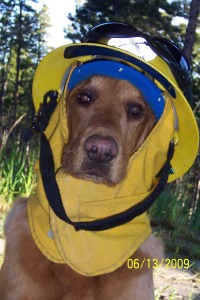
Wily Dog is on the job....
So here’s a lesson in balance: Recently I went through an all-too-typical marketing experience of too many ridiculous deadlines too close together, coming from too many directions/clients. I should know better, I kept thinking, but when I commit, I just duck my head and start toiling away.
Is this wise? Didn’t I learn anything last time my stress level got this high? Has this ever happened to you?
Of course it’s not too far a walk from these legitimate questions to the agonizing yelp: Why are we here?!
If you ever find yourself asking that, take a tip from Wily Dog—it’s time for a vacation. And a fresh perspective, like this one:
This run-around-and-get-it-done-at-all-costs exercise is valid for only one reason: a huge REWARD. It is NO WAY to handle a crisis that we should have seen coming.
Do you see the Wily Dog difference? It’s okay to stress, panic, overwork, flip out for a big tasty cookie like:
• A chance to steal market share when the competition isn’t looking or has a weak moment.
• A chance to place your product or service in a coveted spotlight.
• A once-in-a-lifetime partnership deal.
You get the idea. When an opportunity presents itself, it’s time to haul tail.
On the other hand, no Wily Dog in her right mind should leap through flaming hoops for charred or moldy or MISSING cookies without first asking some pretty tough questions. Like:
• Is this desperate strategy the best strategy?
• How did we get here?
• What about the future? Will this quick fix contribute to long-term success?
• What can we learn from this and how can we avoid it next time? (Write the answers down and post them by the coffee machine. It’s only a disaster if you don’t learn from it!)
Now I’m not saying you’re going to win brownie points by slamming on the brakes when everyone’s rushing for the fire extinguisher. And of course, there’s always those all-hands-on-deck emergencies where you should run into the burning building to save the day. But in my experience (and maybe yours?) true “emergencies” are rare. Most marketing fire drills are actually “failures to plan.” Asking these tough questions may get you some eye rolls, but if everyone agrees the fire drill is the best course of action, even the most impatient will appreciate the scrutiny if they’re proven right.
Look, it’s easy to get into the habit of thinking that marketing is about posting web pages, running promotions, and publishing collateral. But that’s not the WHY of marketing. That’s the how. And because we spend most our hours executing and perfecting the how, we often neglect the why.
The WHY of marketing is the stuff that looks like fluff. Time-wasters! Budget binges! I’m talking about Planning, Researching, Brainstorming, Concepting, and even the much-maligned “worthless” stepchild of Industry, Daydreaming.
What, did she just say Daydreaming?!
I’m not talking about fantasizing about your next trip to the tropics (although this keeps me going most days). I mean OPPORTUNITY SCOUTING. You know, actively and regularly looking for ways to strengthen your brand, create or capitalize on favorable conditions, develop profitable and reliable relationships, support worthy causes…you know, the cookies that make work rewarding.
Next time you find your hair on fire, stop, drop and roll. Get the team to regroup. Before you proceed, commit to do it better next time. And then get into the habit of putting your sniffer in the air to scan for smoke…and cookies!

Where's my cookie?